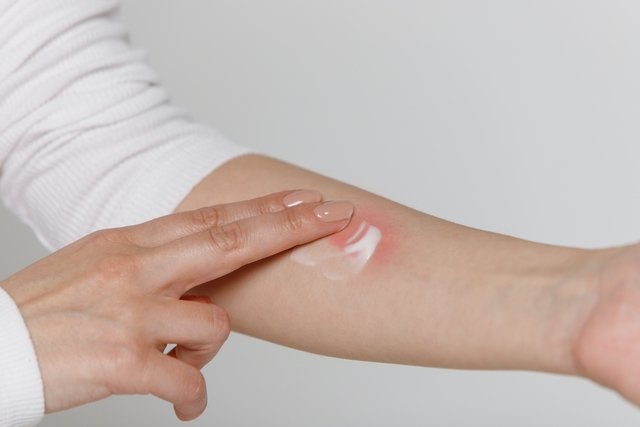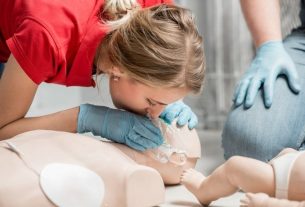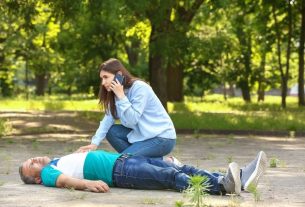A spider bite can be identified through a small wound on the skin and symptoms such as swelling or redness at the site. It is also common for the bite to only be noticed after a few hours, especially if it is caused by a common, non-venomous spider.
Although they can be very stressful accidents, spider bites are relatively common, and most of the time they are caused by non-venomous spiders, which are not life-threatening. Still, it is important to pay attention to signs that may indicate that the bite is serious, such as intense pain, cramps, nausea or fever, which could indicate a venomous spider bite.
In any case, whenever a spider bite is suspected, it is very important to go to the hospital and, if possible, identify the characteristics of the spider that caused the bite.
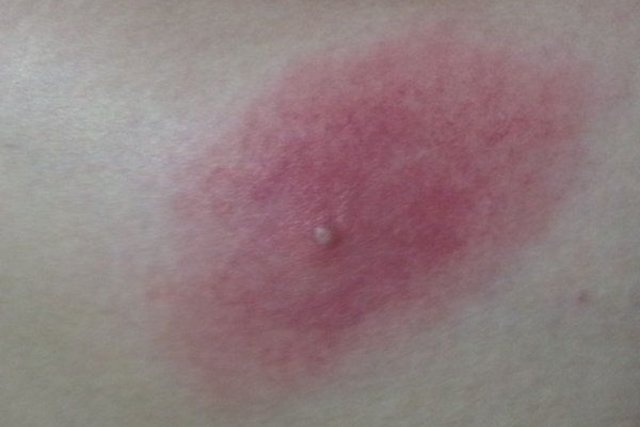
Main symptoms
The main symptoms of a spider bite are:
- Small swelling on the skin;
- Redness at the bite site;
- Small wound on the skin;
- Pain or itching at the bite site.
In addition to noticing the symptoms, it is also advisable to try to identify the type of spider that may have caused the bite. This makes it easier to identify whether it is a potentially poisonous spider. If possible, a photograph of the spider should be taken to the hospital to help doctors identify the type of spider, facilitating treatment and speeding recovery.
Symptoms of a poisonous spider bite
The symptoms of a venomous spider bite tend to be more intense than those of a common spider bite. In addition, other symptoms may appear such as skin blisters, sweating, difficulty breathing, fever, pain, abdominal cramps or stiffness, nausea or vomiting, for example.
Don’t ignore your symptoms!
What to do after a spider bite
If you are bitten by a spider you should:
- Wash the bite site with soap and water;
- Elevate the limb where the bite is;
- Do not tie or squeeze the bite site;
- Don’t try to suck out the poison from the bite;
- Apply cold compresses or a cloth dampened with cold water on the bite site to relieve pain and swelling.
In any case, even if there is no suspicion that the bite could have been made by a poisonous spider, it is important to go to the hospital or a health center so that a doctor can assess the injury and advise the most appropriate treatment.
How to identify a poisonous spider
There are three main species of poisonous spiders in Brazil:
1. Brown spider
Sensitive content
This image may contain content that is uncomfortable for some people.
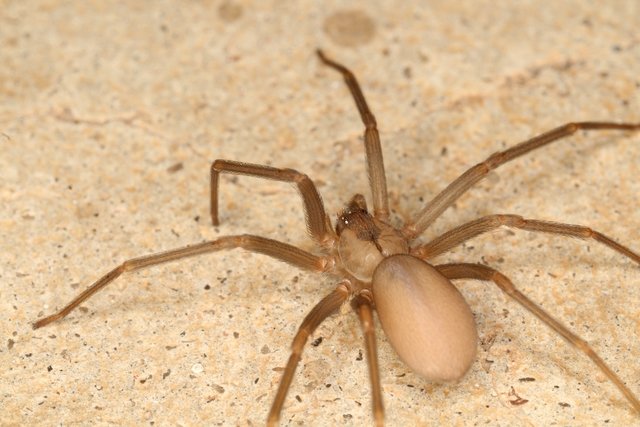
Bites caused by this type of spider are more frequent in the South and Southeast regions of Brazil, such as São Paulo, Paraná or Rio Grande do Sul. The brown spider is a small type of spider that can reach 3 cm in length and its body It is grayish brown in color.
Where are they located: They are more active at night and, therefore, during the day they hide in dark places such as roots, tree bark, behind furniture, in garages, abandoned boxes or bricks, for example.
Sting symptoms: Initially, the spider bite is not felt, but within 24 hours there is pain that increases, redness, blisters and swelling in the area of the bite and the person may also feel fever, malaise and vomiting. After 5 days, it is common for a black crust to appear on the skin, which falls off 2 to 3 weeks later, causing a wound that must be treated in the hospital.
Special cares: You should always keep the area dry and avoid physical activity, as this can help spread the poison throughout the body.
Treatment for brown spider bite
Treatment must be carried out in the hospital with the injection of serum for the brown spider venom. In some cases, especially when more than 24 hours have passed, the doctor may not advise using the serum because its effect may not outweigh the risks.
Furthermore, the scab caused by the spider bite must be removed through surgery to facilitate healing and on-site treatments must be carried out by a nurse at the hospital. In more serious cases, where the bite affected a very large area, it may still be necessary to undergo surgical repair of the area.
2. Armadeira spider bite
Sensitive content
This image may contain content that is uncomfortable for some people.
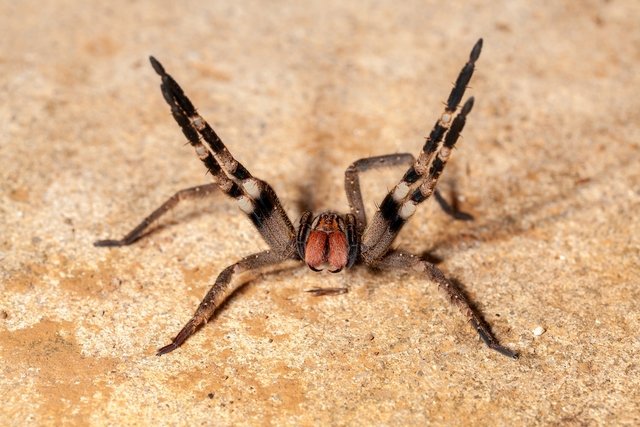
These bites are frequent throughout Brazil, as it is possible to find this spider throughout South America. However, there is a greater number of cases during the months of March and April in the Southeast of the country, as these are periods in which the armored spider is most active.
The armored spider is generally a large spider with a body measuring 4 cm, but can reach 15 cm in length with its legs. Its body is grayish brown or yellowish. This type of spider is known for adopting a defense position that consists of supporting itself on the last 2 pairs of legs, raising its head and front legs. They can also jump up to 40 cm away.
Where are they located: they can be found in dark and damp places such as tree bark, fallen logs, banana trees, inside shoes, behind furniture or curtains, for example.
Sting symptoms: Intense pain appears immediately after the bite, accompanied by marks, swelling and redness at the site of the bite. In addition, an increase in heart rate, excessive sweating, vomiting, diarrhea, agitation and an increase in blood pressure may occur.
Armed spider bite treatment
Treatment must be carried out in the hospital with the injection of anesthetics at the site of the bite to help reduce the pain, which ends up disappearing within 3 hours after the accident. Only in cases of more serious symptoms, such as decreased heart rate or shortness of breath, is it necessary to undergo treatment with serum for this spider’s venom.
3. Black widow spider bite
Sensitive content
This image may contain content that is uncomfortable for some people.
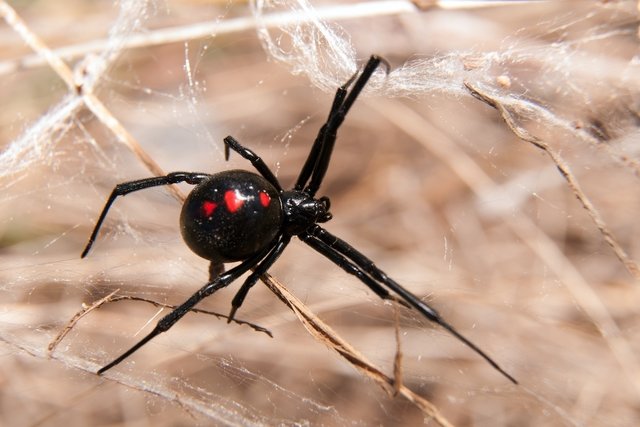
This type of spider is more common near sea regions, especially near abandoned beaches, but bites can occur throughout Brazil, as the black widow is distributed throughout tropical and temperate regions.
The black widow is a small type of spider, measuring about 2 cm, which has long, thin legs, as well as a black body with a spot on the belly, usually red. Although this spider does not attack, it can bite when pressed against the body.
Where are they located: They remain in damp and dark places and, therefore, can be in places such as bushes, tires, empty cans, shoes and lawns, for example.
Sting symptoms: They begin with a sharp pain at the site of the bite, as if a pin were being pricked, and after 15 minutes the pain turns into a burning sensation that worsens over 48 hours. Symptoms such as nausea, vomiting, muscle pain and increased body temperature are also common.
Black widow spider bite treatment
Treatment must be started in the hospital as soon as possible with the injection of specific serum for the spider venom. Symptoms usually improve within 3 hours after starting treatment, but the patient must remain hospitalized for 24 hours to see if symptoms return.
Knowing what to do in these types of situations is important to save a life. Therefore, learn what to do if you are stung by other animals such as a snake or bee.
How to avoid spider bites
To prevent a person from being bitten by a spider, it is important to keep the house and vacant lots clean, as it is in dirty and humid places that these animals breed and live. The accumulation of rubble and construction materials also favors proliferation and, consequently, a person who works and lives close to these places is more likely to be bitten by spiders and even scorpions, which is why these products should be avoided. Find out what to do in case of a scorpion sting.
Furthermore, people who live in places where these animals are infested should always shake out their clothes before putting them on and it is also necessary to beat shoes and boots before putting them on, as this prevents bites from occurring.

Sign up for our newsletter and stay up to date with exclusive news
that can transform your routine!
Warning: Undefined array key "title" in /home/storelat/public_html/wp-content/plugins/link-whisper-premium/templates/frontend/related-posts.php on line 12
Warning: Undefined array key "title_tag" in /home/storelat/public_html/wp-content/plugins/link-whisper-premium/templates/frontend/related-posts.php on line 13

